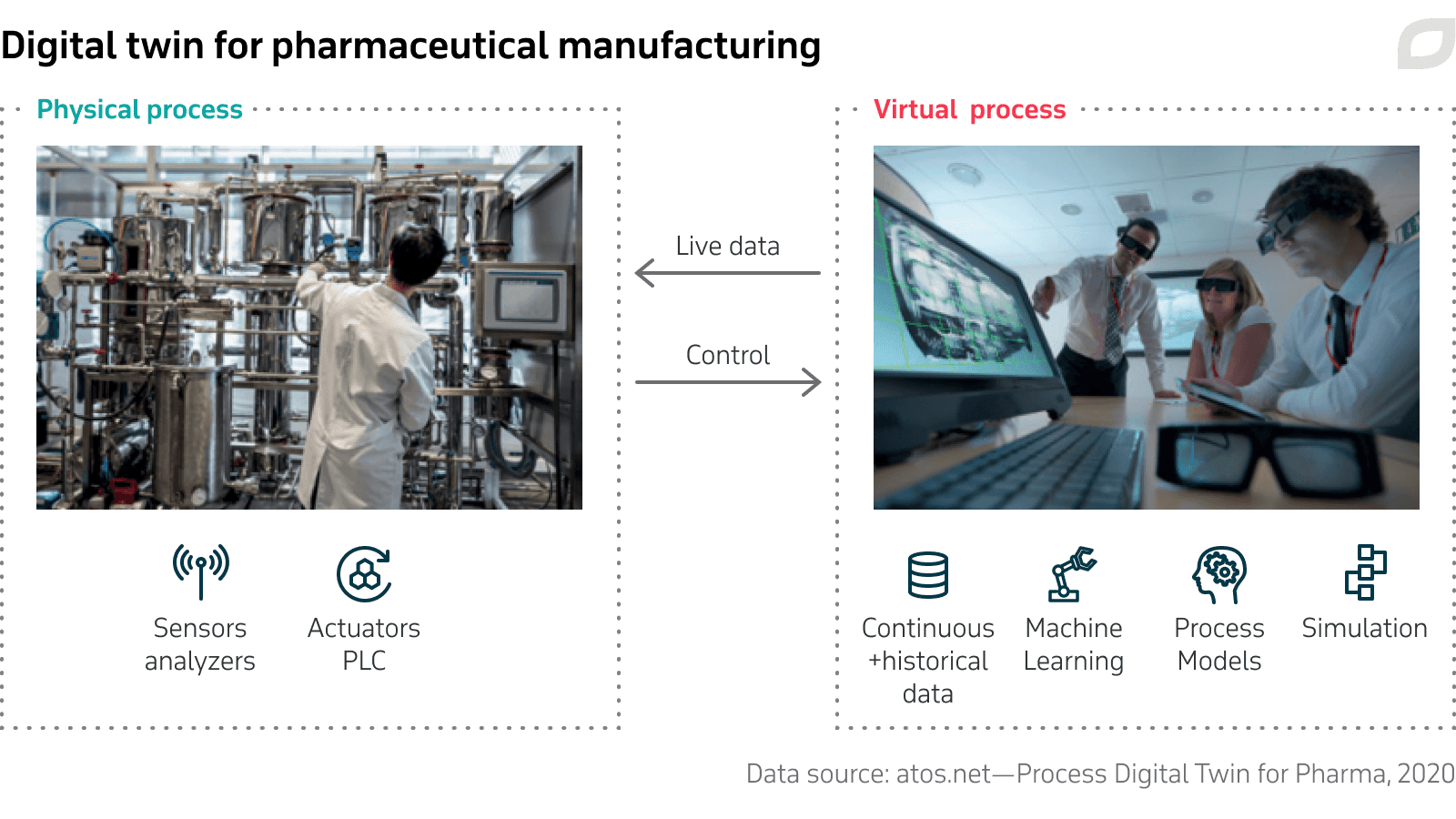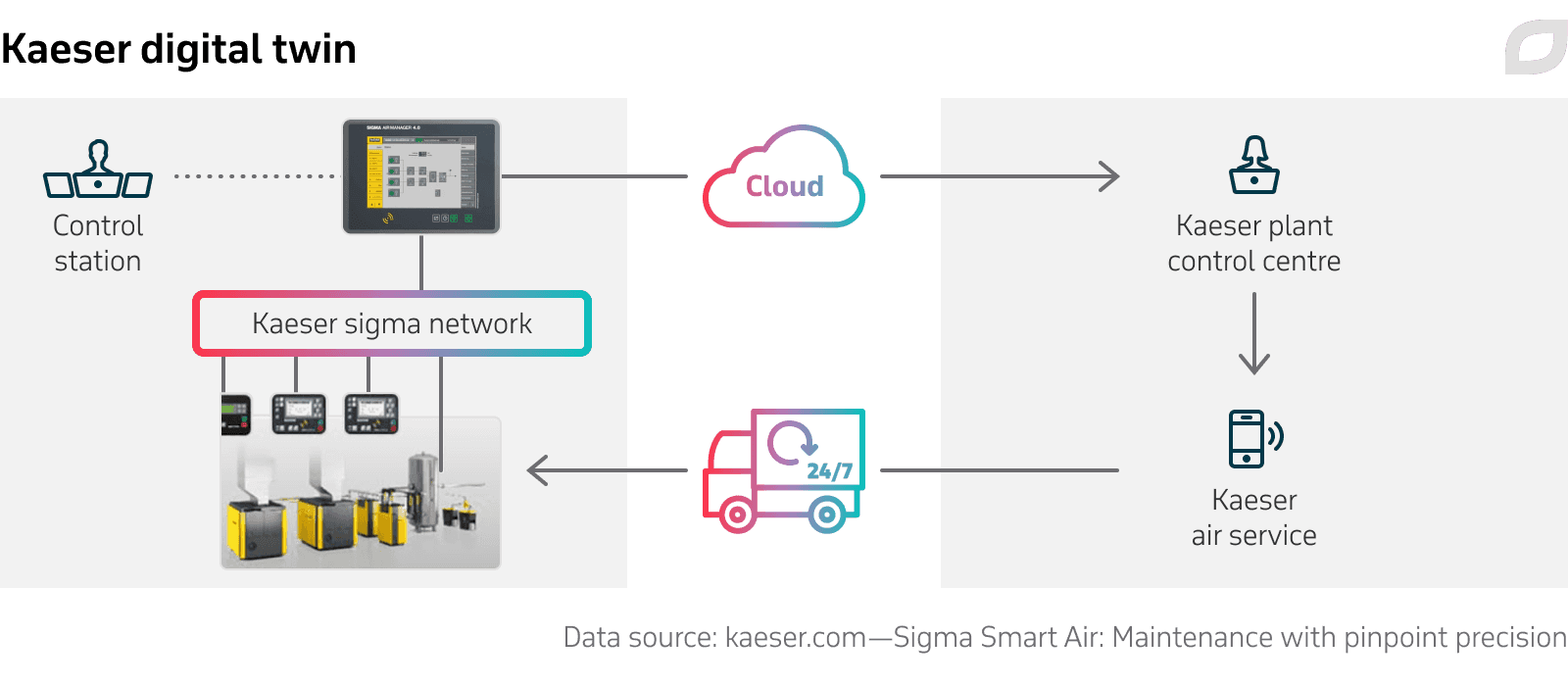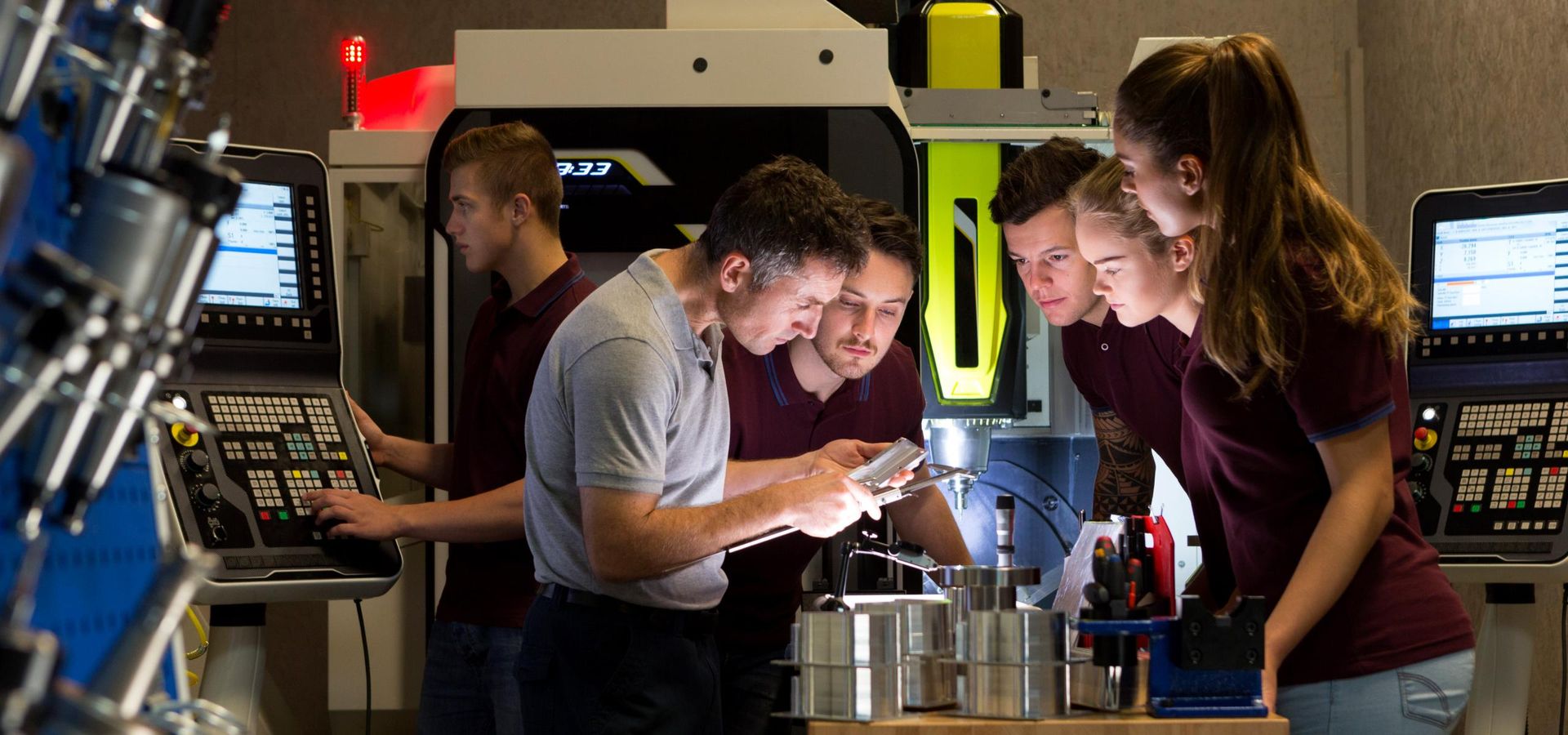While the concept of digital twins may make you think it is straight out of a sci-fi film, the technology’s concept was first described more than 20 years ago. Forward-looking manufacturing companies have been continuously exploring how they can apply virtual reality development to optimize plant performance and improve products.
However, the long-awaited hype around digital twins has started only recently. As with other aspects of digital transformation in manufacturing, this increase of interest can be largely explained by the advancements in computing power, cloud, big data applications, and accessibility of IoT sensors. And with the ability to store and process enormous volumes of data with a data lake or a data fabric solution, it’s now possible to simulate products and processes in much greater detail, which is what the digital twin is all about.
What is a digital twin?
In short, a digital twin is a digital replica of a physical entity that simulates the object’s current and historical conditions. The object’s profile is generated using a myriad of data points that sensors installed across it capture and send to a cloud-based system for further analysis. So, in a nutshell, there are four technologies that comprise a digital twin:
-
Manufacturing IoT system to gather data about the physical object
-
XR to visualize physical objects in 3D
-
Cloud to store data gathered from IoT sensors
-
AI and ML-based manufacturing tools to analyze object data, generate insights, and make predictions
The role of a digital twin in a modern production plant
The main benefit of digital twins in manufacturing is their ability to automatically provide comprehensive information about equipment or product performance without any involvement from employees. What is more, putting today’s computing capabilities to use, factories can quickly analyze the data provided by the physical twin using advanced ML algorithms and turn it into actionable insights. Prior to the inception of digital twins, such a level of control in manufacturing was unattainable.
Manufacturing is one of those industries which is as complex as it looks. Plants usually have highly-complicated pieces of machinery that constantly interact with each other. This complexity obscures the understanding of what can be improved at the production site and, most importantly, how.
But with thousands of sensors installed across the plant and constantly streaming data to a digital twin application, manufacturers can accumulate important insights about the system’s performance and make evidence-based adjustments to the plant’s workflow. To top it off, modern sensors can gather data about a wide variety of characteristics ranging from asset thickness and temperature to general environmental conditions at the plant.
A digital twin can help manufacturers understand the past, view present conditions, and prevent future problems, enabling informed decision-making through insight, analysis, simulation, and prediction.
With the help of sensors, digital twins can monitor assets outside the manufacturing facility. For example, a car plant can assess how various car components wear and tear or perform under extreme conditions. These insights can be used to enhance future product design. A digital twin also enables manufacturers to experiment with unconventional design decisions without any economic risks and drive innovation.
In a nutshell, a digital twin allows manufacturers to overcome legacy challenges and achieve various business imperatives at once.
Looking for a digital twin solution for your business?
Top digital twin use cases in manufacturing
In the manufacturing context, digital twins can be applied in a multitude of ways. Let’s explore how exactly some of the world’s leading manufacturing companies are using digital twins to their advantage.
Digital twin manufacturing use cases
|
Encourage innovation Digital twins allow manufacturers to prototype and test new products inexpensively, driving innovation. |
Increase efficiency By modeling highly complex processes from their plants, manufacturers can easily determine inefficiencies and address them. |
Enable predictive maintenance Digital twins enable manufacturing companies to proactively monitor equipment condition, identify potential failures, and reduce downtime. |
|
Optimize product performance Keeping track of the product even when it leaves the facility, manufacturers get insights for its performance optimization. |
Decrease time to market With the help of a digital twin, companies can assess product quality and performance before it goes to production, shortening time to market. |
Improving product quality
Realizing the ever-increasing need for drugs and vaccines in particular, Atos, GlaxoSmithKline, and Siemens have joined forces to transform pharmaceutical manufacturing.
Conventionally, pharmaceutical companies can assess the product’s quality only after it has been made, meaning that if it’s low, the whole batch has to be discarded, resulting in a waste of time and materials. Digital twins allow for evaluating product quality in the midst of the production, helping manufacturers to promptly tweak the operations and meet the quality criteria.

Together with Siemens, Atos implemented a digital twin which gathers data about each stage of the vaccine manufacturing process. This digital twin allowed the pharmaceutical company to considerably improve product quality, cut costs and decrease time to market. On top of that, the pharmaceutical company can now also simulate changes in the production and clearly see how they will affect the end product.
Predicting product failures
To meet the growing demand for their industry-leading screw compressors, Kaeser decided to integrate a digital twin into their new production facilities. In Kaeser’s case, the products have to meet a particular customer’s needs, which significantly complicates quality control. Their compressing systems have a considerable number of parameters that need to be customized for each customer. What is more, depending on the environment, Kaeser’s customers can choose between air and water cooling systems and add a dryer or a heat recovery system to their compressor.
With the help of a digital twin, Kaeser employees can determine the exact product test routines before it is assembled. Once a compressor is out of the assembly line, test sequences are launched with a push of a button. If the rest results don’t match the required criteria, the system informs an operator who manually adjusts compressor parameters.
Kaeser’s use of a digital twin also goes beyond their manufacturing facility. Every released compressed air system is also virtually replicated by a digital twin. This allows operators to monitor the state of each compressor, allowing for remote detection of potential faults and timely maintenance. This significantly prolongs the product’s life, increases customer satisfaction, and reduces maintenance costs.

Decreasing time to market
When it comes to the production of luxury cars, there is no room for compromise on quality. On the other hand, meticulous quality control can be rather time-consuming. So, to speed up their car development process without cutting corners, Maserati, one of the most renowned car manufacturers in the world, collaborated with Siemens to integrate a digital twin into its manufacturing process.
With the help of Siemens PLM software, Maserati engineers can now use data from the virtual copy of cars to continuously optimize their development. For example, the conventional method for assessing the vehicle’s aerodynamics calls for building the car’s physical prototype and placing it in the wind tunnel. With the digital twin, such tests can be run virtually, which significantly reduces costs and allows for more elaborate experiments with the car’s aerodynamics.
Thanks to NX, we can now obtain analysis results which, until recently, we were only able to achieve by constructing physical prototypes
As a result of digital twin implementation, Maserati has managed to decrease operational costs and time required for car development by an impressive 30%. Thanks to the digital twin, the company also decreased time to market by 16 months.
Improving user experience
Initially, Stara, a Brazil-based manufacturer of farm machinery, aimed to apply digital twins to improve performance and optimize the maintenance of their farming equipment. Having installed IoT sensors across tractors and other farm machinery, they were able to monitor a tractor’s path, speed, fuel consumption, and engine condition. This allowed Stara to predict machinery failures and prolong equipment uptime.
While leveraging the advantages of digital twins for performance enhancement, Stara discovered that this technology can also optimize farmers’ use of the machinery. Embedded IoT sensors now gather both weather and soil properties data, helping farmers to determine the best conditions for planting crops.
Streamlining product development
Implemented in tire manufacturing companies, a digital twin facilitates product engineering and testing without building prototypes. Besides reducing time to market and development costs, the elimination of physical prototyping allows manufacturers organizations to reduce the negative environmental impact caused by prototype waste.
What is more, for tire manufacturing companies, digital twins have proven to be especially beneficial for streamlining collaboration with other automotive companies. For example, Bridgestone, the world’s leading tire manufacturer, now uses a digital twin to share virtual replicas of upcoming products with their partners for approval. The data science director of the world's second tire manufacturer, Michelin, also claims that the digital twin has huge potential for building highly-effective partnering ecosystems, allowing organizations to seamlessly share development data with each other.
Michelin, in their turn, uses a digital twin to test various tire designs and predict equipment failure. To be more specific, the company uses this technology to simulate tire behavior on wet roads to identify optimal tread pattern design. Engineers at Siemens, arguably the most popular provider for digital twin technology in the automotive sector, also claim that it’s possible to simulate tire performance on different surfaces and in varying weather conditions.
The digital twin is undoubtedly a key enabler for efficiencies across the whole engineering chain
Reinvent your manufacturing with a digital twin.
Final thoughts
Undeniably, the digital twin is the new essential technology in manufacturing. Its ability to drive value, shorten time to market, optimize the performance of both onsite equipment and finished product, and provide insights is unlikely to be matched by any other solution. With the decreasing costs, an increasing number of vendors, and improving accessibility of advanced technologies that comprise the digital twin, integration of digital twin should be the next logical step for manufacturers around the globe.
However, it’s also worth noting that companies with highly complex processes that prioritize innovation and improving or expanding their product range will benefit the most from a digital twin. By no means this technology is cheap or easy to implement, as it often requires a complete revamp of organizational structure and considerable changes in manufacturing workflows.






